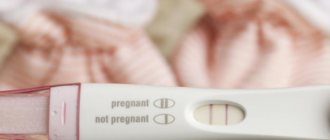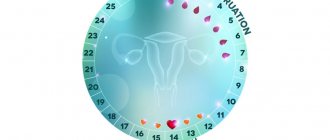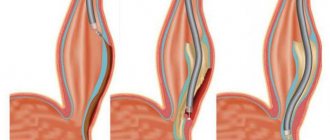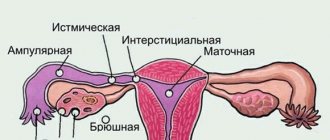Irregular periods
- is the most common symptom of most gynecological diseases. Irregular periods may only be a temporary glitch in the system, and may not reflect all other possible menstrual defects. Irregularity of menstruation is almost always associated with a disturbance in its appearance: it can become more abundant, painful, etc. Therefore, it is correct to talk about menstrual irregularities. However, it is the irregularity of the onset of the next menstruation that is the most common reason for visiting a doctor among all menstrual cycle disorders.
Irregularity of menstruation can be physiological and pathological, be a symptom of many gynecological and non-gynecological diseases, be the cause of infertility, due to the frequent accompaniment of cancellation, or not bother the woman at all and not cause any manifestations in her. We can talk about the importance of establishing the nature of menstruation. Therefore, taking a medical history by your doctor is an important part of treatment planning.
Normally, the menstrual cycle lasts from 21 to 31 days, with possible variations of ±5-7 days. If the break between menstruation is 40-60 days or less than 21-25 days, and such changes occur over a long period of time, we can assume that the cycle is irregular
.
Causes of irregular periods.
Irregular periods
arise for reasons such as:
1. Physiological ones come first. Abortion measures and childbirth affect the cycle. It may become erratic or irregular. For the most part, the body recovers on its own, but there are situations when minor treatment is required, which is most often limited to the prescription of oral contraceptives. There is also the option that menstruation, which has been irregular since the establishment of the cycle, can become regular after childbirth. Therefore, doctors often do not interfere with the cycle of young girls with irregular periods without other symptoms of cycle disruption and other pathologies, until pregnancy occurs and the first birth is resolved.
2. In second place are pathological changes:
Various degrees of tumor, disorders at the level of the hypothalamic-pituitary system - cycle irregularity
in this case it is associated primarily with hormonal deficiency.
Tumors of the ovaries, they are called cysts. They are the main causes of ovarian dysfunction. Polycystic disease is becoming the most common manifestation. . Chronic inflammatory diseases of the uterine walls (fibroids, polyps).
Endometriosis. Clinical symptoms may include: painful menstruation, pain in the pelvic area, uterine bleeding, and bloody discharge from the genital tract in the intermenstrual period will be observed.
Long-term use of contraceptives or incorrect selection of contraceptives on your own without a doctor’s prescription.
To find out what is the cause of irregular periods
You must consult a gynecologist or gynecologist-endocrinologist.
Diagnostic methods are:
1. Life history and medical history of the patient
2. Blood tests for hormonal changes
3. Ultrasound of the pelvis and abdominal cavity
5. Hysteroscopy
https://youtu.be/cXiq8iYU8tc
Symptoms
https://youtu.be/SZSG7Bvr1s4
Cycle disorders are manifested by changes in the frequency of menstruation, as well as their nature. There may be various variants of such dysfunctions, which is determined by a violation of regulatory mechanisms at various levels - from the cerebral cortex to the uterus - provoked by an underlying disease or other condition. Therefore, to find out the cause of irregular periods, you need to consider the main symptoms of the pathological cycle. These include:
- Amenorrhea – absence of menstruation.
- Polymenorrhea - an increase in the duration of the cycle.
- Oligomenorrhea – decreased cycle duration.
- Proyomenorrhea – frequent discharge.
- Opsomenorea – infrequent menstruation.
- Hypermenorrhea – heavy periods.
- Hypomenorrhea – scanty bleeding.
- Algodismenorrhea – painful menstruation.
In girls and women after 40 years of age, an irregular cycle can manifest itself with the same symptoms, but the reasons can be radically different.
Endometriosis
Endometriosis refers to a common gynecological pathology in which endometrial cells develop outside the lining of the uterus. It is more common at a young age than in women after 40 years of age. This is due to the fact that during active reproductive age the concentration of sex hormones responsible for endometrial growth is higher. The disease is characterized by the appearance of:
- Algodismenorrhea.
- Spotting between periods.
- Uterine bleeding.
- Pain during sexual intercourse (infrequently).
In many cases, endometriosis is completely asymptomatic, but despite this, it is accompanied by quite serious complications - adhesions, infertility, tumor degeneration. Sometimes the disease is disguised as another pelvic pathology, and often it becomes difficult to make a diagnosis without additional examination.
Half of the cases of female infertility are due to endometriosis. Therefore, during a gynecological examination of women with menstrual irregularities, it is always necessary to remember the likelihood of such a pathology.
Tumors of the uterus
Irregular periods often occur with tumor diseases of the uterus: fibroids, polyps, endometrial hyperplasia. Quite often, this situation occurs among women after 40 years of age, when hormonal changes take place, unfavorable factors accumulate and the risk of tissue degeneration increases.
If the size of the tumor is insignificant, the disease may be asymptomatic, but as the size increases, the nature of the cycle changes - intermenstrual bleeding appears - at first insignificant, and later increasingly depleting the woman’s body. As the tumor grows, pain may appear in the lower abdomen or lower back, which intensifies during sexual intercourse. Fibroids often reach significant sizes, and uterine polyps during reproductive age can lead to infertility.
A dangerous disease is uterine cancer. It most often occurs in women after 40 years of age, during menopause. In this case, uterine bleeding (metrorrhagia) is observed, and cloudy discharge from the genital tract is possible. As a result of tumor growth into nearby tissues, pain and dysfunction of the pelvic organs are observed.
Women should always be on alert for cancer, especially after 40 years. You should regularly undergo preventive examinations and do the necessary examinations.
Ovarian diseases
Ovarian pathology is one of the causes of menstrual dysfunction. If you have irregular periods, this may occur due to inflammatory processes (salpingo-oophoritis), polycystic disease, developmental abnormalities (leg torsion, hypoplasia).
Polycystic ovary syndrome occurs in 5% of women of reproductive age and is one of the leading causes of infertility. Along with various menstrual cycle disorders, including anovulation, the following symptoms are observed:
- Obesity.
- Male pattern hair development (hypertrichosis).
- Baldness, acne.
- Ovarian enlargement.
Chronic inflammatory diseases are accompanied by spotting bloody discharge and nagging pain in the lower abdomen. Untreated pathology leads to tubal infertility due to the development of adhesions.
Having determined why a woman has an unstable menstrual cycle, it is necessary to begin treatment immediately. With adequate therapy, reproductive function can be normalized.
Treatment of irregular periods.
The main and main thing in treatment is to identify the primary cause of the disorder. It is also a fact that young girls and women over 45 may have irregular periods for a long time; this is due to physiological unpreparedness or exhaustion of the body. At a young age, the immune system is still being established, and this takes a certain amount of strength from the body, so menstruation can take a long time to form. And after 45 years, in women, the body begins to adapt to a different pace of life of the body’s cells. In cases where irregular periods require medical intervention (for example, to conceive a child), treatment begins with identifying the root cause. Because you need to plan your treatment.
The main treatments used for irregular periods are:
1. Oral contraceptives, usually containing progesterone: Duphaston - 1 tablet. 2 times a day, Utrozhestan 1 capsule 2-3 times a day, etc. It is also possible to prescribe intramuscular injections. The doctor will decide this. Which medication administration is appropriate for the patient.
2. If the root cause is inflammatory diseases, then it is first necessary to treat them, and then cycle treatment will follow, if necessary. Antibiotics for inflammatory diseases (Ofloxocin 1 tablet 2 times a day for 7 days).
3. Curettage of the uterine cavity to remove polyps.
4. Surgical treatment for removal of ovarian cysts, polycystic disease.
Changing the patient's lifestyle can affect the establishment of a normal cycle:
To give up smoking
Reducing stressful situations
Avoiding strict diets and strenuous exercise
All these factors can favorably affect health and the menstrual cycle
can recover without doctor intervention.
Phytotherapy methods are also possible. These include tinctures and decoctions of verbena, St. John's wort, motherwort, rue herb, fennel, and buckthorn bark. They are not contraindicated for persons from 14 to -30 without serious pathological disorders.
Of course, proper nutrition is necessary, food must be high in calories. Protein foods and foods containing easily digestible carbohydrates are required. Any depleting diet is a direct contraindication in case of an irregular monthly cycle
.
You need to give your body rest and reduce stress both at home and at work. If necessary, sanatorium-resort treatment is indicated.
Irregular menstruation may indicate problems with a woman's reproductive system. For many representatives of the fair sex, deviation is an early symptom of infertility.
A cycle is considered irregular when the number of days between periods is more or less than normal. It usually lasts 21-35 days.
Also, menstruation can be considered irregular when it varies by a certain number of days. For example, if a woman's cycle usually lasts 32 days, but sometimes changes by a day or two, then this is considered normal. And when it “”, for example, lasts either 25 days or 32 – this is a pathology.
Some women believe that any deviation from the generally accepted norm of 28 days is an irregular menstrual cycle. This is nothing more than a delusion. This number is an average. A girl's cycle can be longer or shorter, but high fertility is possible.
Do irregular periods indicate illness?
The female menstrual cycle is a complex of monthly changes in a woman’s body that occurs throughout her reproductive age, providing the possibility of conceiving a child. These processes are regulated by a complex neurohumoral mechanism with the participation of:
- cerebral cortex;
- hypothalamus;
- pituitary gland;
- gonads;
- peripheral organs and tissues - uterus, fallopian tubes, mammary glands, etc.
The cycle consists of three main phases, during which corresponding changes occur in the ovaries and in the endometrium of the uterus. Female reproductive function is carried out due to the following processes occurring during these phases:
- Follicular. The production of luteinizing (LH) and follicle-stimulating (FSH) hormones increases, under the influence of which follicles mature in the ovary. Its duration ranges from 5 to 8 days.
- Ovulatory phase. It lasts about three days and ends with ovulation. This is the moment a mature egg leaves the dominant follicle, ready for fertilization.
- The final phase is called the luteal phase. During this period, the corpus luteum actively produces progesterone, which prepares the endometrium of the uterus for implantation of a fertilized egg. If conception occurs and the egg “takes root” in the uterus, pregnancy occurs. If pregnancy does not occur, the corpus luteum is destroyed, the level of estrogen and progesterone drops sharply, and this is a signal for the resumption of the production of LH and FSH, the start of a new cycle. Its first day is considered to be the day the menstruation begins, during which the uterus is cleared of the remnants of excess endometrium from the previous cycle.
The normal length of the cycle is considered to be from 21 to 35 days (28±7 days). The normal duration of menstruation is from 2 to 6 days (4±2), the volume of blood loss is from 20 to 60 ml. The indicated ranges refer to the norm, plus a one-time deviation of 3-5 days is considered normal. Regular cycle shifts of 6 days or more may indicate irregularities.
During reproductive age
Irregular menstrual cycles during reproductive age are the result of three main groups of factors. This is the impact of the external environment, diseases of the reproductive system or systemic failures in its functioning, as well as failures caused by taking medications. A separate group includes changes in hormonal levels after pregnancy, childbirth, cesarean section, lactation, miscarriage, abortion, unsuccessful IVF, and during the premenopausal period. The main reasons for shifts in the dates of monthly bleeding include:
- External - climate change, nervous exhaustion or chronic stress, changes in diet.
- Physiological – hormonal imbalances. The first symptoms of such disorders are weight gain and hair growth in uncharacteristic places.
- Diseases of the reproductive organs or other systems - ovaries, uterus, liver, gallbladder and adrenal glands. Pathological disorders of the interaction of the pituitary gland and hypothalamus, the process of blood clotting, endocrine disorders, hormone-dependent tumors, cancer, deficiency of vitamins and other compounds significant for metabolic processes, the consequences of bad habits (smoking, drug addiction, alcoholism).
- Taking hormonal contraceptives, antidepressants, glucocorticosteroids, anticoagulants and other drugs.
Article on the topic: Antidepressants without a prescription - list of the best with names
In teenagers
Unstable periods in adolescence, at the stage of puberty of a girl, are more a natural phenomenon than a deviation. The hormonal background is unstable, the body needs time to adjust to the changes occurring in it. From the moment of menarche (the first menstruation) until the cycle stabilizes, on average, about a year passes, that is, from 17 to 11 cycles. When a girl is keen on various diets and associated weight fluctuations, the likelihood of irregular bleeding increases. The period of puberty is characterized by juvenile uterine bleeding.
During menopause
During the period of the body’s preparation for menopause, which occurs after 45 years and ends the reproductive period of a woman’s life, the menstrual cycle is disrupted due to serious hormonal changes in the body against the background of a depleted supply of eggs. The process is accompanied by acyclic and cyclic, heavy or scanty irregular bleeding due to hyperplastic processes occurring in the endometrium of the uterus. In some cases, such conditions require drug correction and the use of hormone replacement therapy.
Causes of irregular menstrual cycle?
In young people who have not yet turned 16 years old, an irregular cycle is not considered a pathology, because it is in the process of formation.
However, you need to monitor your menstruation, and if such “jumps” continue for more than a year, then you need to consult a gynecologist. If a woman suddenly loses weight, then an irregular cycle is also possible. If there is a lack of nutrients, the body rebuilds itself and “understands” that pregnancy is undesirable during this period.
Gaining pounds can also cause your menstrual cycle to fluctuate. To restore it, you need to get rid of excess weight.
Hormonal imbalances, especially damage to the pituitary gland, have a great impact on the menstrual cycle. If you have this problem, then you need to seek help from an endocrinologist.
Diseases of the female genital organs, such as polyps and cysts, also cause disruptions in the menstrual cycle. Quite often, surgical intervention is required to get rid of such problems.
After childbirth and during lactation, an irregular cycle and even a complete absence of menstruation is considered normal. In order for everything to return to normal, the body will need some time to recover.
If a woman, while on vacation in some hot country, notices that her period has not arrived, or has shifted by a certain number of days, then you should not be surprised. Climate change has a strong impact on a woman's cycle. Upon arrival home everything will return to normal.
Irregular periods are one of the most common symptoms of various pathologies. Most often, this applies to those cases when, against the background of an unstable cycle, the nature of menstrual flow changes: it becomes abundant, and the painful sensations intensify.
Sometimes unstable critical days can be one of the normal options that does not require treatment.
An irregular cycle is considered normal if it is caused by physiological factors. These include:
- recent abortion;
- curettage procedure after miscarriage;
- postpartum period.
In these situations, the unstable cycle normalizes on its own.
At 40 years of age, irregular periods may be a consequence of perimenopause - the period preceding menopause. This phenomenon is possible against the background of changes in the body, characterized by a decrease in ovarian function.
Menstruation may begin to appear erratically before menopause. For about a year after age 45, women experience irregular periods and then they disappear. In this case, the absence of menstruation is due to the physiology of the female body and is the norm.
How to calculate your menstrual cycle?
So, it’s clear what the menstrual cycle is, and what it should normally be like. But how exactly is it calculated? There are several ways to do this. Having learned about the features of these calculations, you yourself can decide which of these methods is right for you.
Recently, many modern women prefer to use computer technology for this. There are now a lot of programs on the Internet that quickly perform all the necessary calculations. So, by entering your menstrual data, you can determine the duration of the menstrual cycle and find out the moment of ovulation. Thanks to such programs, you can find out the date of pregnancy, time of birth and even the gender of the child. Thus, you can find out the periods of changing phases of the menstrual cycle and determine the time of onset of premenstrual symptoms. Gynecologists approve of this method, as it is very convenient. When you go to the doctor, you can print out the results.
You can do the calculations yourself, doing it manually. But to do this, you need to observe the behavior of your body over a certain period of time (at least the last 6 months). Based on data for six months, it will be possible to identify the shortest and longest menstrual cycles. Based on these data, it will become known how stable your menstrual cycle is. If it is subject to fluctuations, this will also become obvious. By making a graph from this data (the usual one - like in mathematics lessons at school), you can clearly see how the curve changes, perhaps then it will become clear why this is happening if you compare the circumstances that took place (nervous or physical overload, lack of sex life, etc.).
To determine the so-called safe days, you need to subtract 18 days from the number of days of the longest menstrual cycle, and subtract 10 days from the number of the shortest cycle. The resulting numbers will mean the following: the first digit is the number of safe days at the beginning of the month, and the second at the end. These days will be safe from unwanted pregnancy. But the period between these two numbers is the most favorable for conception.
The most effective method of calculating the menstrual cycle is considered to be regular measurement of your basal temperature. This is the body temperature in the internal organs (measured in the vagina or mouth), capable of changing under the influence of female sex hormones. It should be noted that this temperature should be measured early in the morning, immediately after waking up. The obtained indicators are presented in the form of a simple graph, the data of which doctors rightfully consider the most accurate indicators. Once you start measuring your temperature for one calendar month (every day), you will soon notice such changes.
So, the received data is decrypted as follows. From the first day of menstruation until the moment of ovulation, the basal temperature is at around 36.6 - 36.8 degrees Celsius. If on a certain day the temperature drops to 36.4 degrees, this is the day ovulation begins. The entire period as long as the temperature remains below 37 degrees is a favorable period for conception. Then the second phase of the menstrual cycle begins (temperature 37 degrees), this temperature remains until the beginning of the next menstruation. It is important to know that each woman’s temperature fluctuations can be expressed differently. Therefore, for correct calculations, it is necessary to take into account the slightest temperature fluctuations as much as possible (if they are constantly recorded, this will be immediately visible).
Pathological causes of infrequent periods
Irregular cycles can be caused by various diseases of the reproductive organs. There is a whole list of pathologies that contribute to:
- tumors;
- uterine fibroids;
- polyps;
- chronic endometritis;
- endometriosis.
Also, the reasons why periods are irregular are the incorrect selection of contraceptives and their prolonged use. Such factors affect a woman’s hormonal levels, causing menstrual cycles to be disrupted.
Irregular periods at any time in a woman’s life can be caused by other health problems that cause hormonal imbalance:
- diseases of the endocrine system, including the thyroid gland;
- dysfunction of the hypothalamus and pituitary gland;
- rapid change in weight.
With an abnormal structure of the reproductive organs, for example, with a double uterus, the presence of a septum in it, infantilism, menstruation becomes irregular. Also, the causes of such a disorder can be psychological disorders, abuse of bad habits, vitamin deficiency, and chromosomal diseases.
Primary oligomenorrhea
Hormonal drugs are used to treat oligomenorrhea. If there is a risk of developing infertility, doctors prescribe Choriogonin, Pergonal. If a woman rarely ovulates (or does not ovulate at all), Clomiphene is prescribed to stimulate this process.
During therapy, bad habits should be completely abandoned, as they can weaken the effectiveness of the medications. Additionally, after consultation with a doctor, a woman is allowed to be treated using folk remedies.
To restore the cyclicity of menstruation, you can use the following effective recipes:
- A couple of tablespoons of sesame seeds are crushed using a coffee grinder. The resulting mass is mixed with 1 dess. l. palm oil. The medicine is taken once a day, 1 dess. l. This product contains a plant analogue of female sex hormones, which helps regulate the cyclicity of menstruation.
- Ground ginger (0.5 tsp) is poured into 1 glass of water. The liquid is boiled for 5 minutes, removed from the heat and filtered. This tea helps regulate the cyclicity of menstruation, as well as reduce pain when it occurs.
- Honey and aloe juice are mixed in equal proportions. The resulting product is taken on an empty stomach, 0.5 dess. l. for 1 month.
To normalize menstruation, a mixture of honey and turmeric, coriander, mint, and fennel can be used. Also, many doctors recommend drinking carrot juice: 1 glass every day for 3 months.
If a woman does not want to become pregnant during treatment for a period disorder, she should use contraception, but it is not recommended to take contraceptive medications, as they can affect hormonal levels.
In some cases, doctors prescribe, learn about this in more detail from a separate article on our website.
Preventive measures
Prevention of irregular menstrual cycle is aimed at preventing provoking external and internal factors. You can prevent the occurrence of hormonal imbalances using the body’s natural forces by following a number of simple recommendations:
- minimize stressful situations. If, due to a number of life circumstances, a woman is constantly under stress, she is advised to take a course of sedatives: Sedavit, Adaptol, etc.;
- organize nutritious meals;
- take multivitamin complexes to avoid weakening the immune system and the development of vitamin deficiency;
- give up bad habits (drinking alcohol, smoking);
- follow measures to prevent pathologies of the reproductive system and STDs;
- Check regularly with a gynecologist (at least once a year).
Consequently, irregular periods can be caused by both external and internal factors and be of both physiological and pathological nature. The nature of the phenomenon can be determined by a doctor who will not only establish the fact of pathology, but also determine the type of menstrual disorder. Based on the diagnosis, appropriate therapy is carried out aimed at restoring the regularity of menstruation. Therapeutic measures can be aimed at eliminating the primary disease or involve changing lifestyle, contraceptive methods, relieving concomitant symptoms, and hormonal therapy. Folk remedies in the case of irregular menstruation are justified only as an auxiliary therapy, subject to prior medical consultation. Prevention of pathology is aimed at preventing the occurrence of provoking factors.
Source
Planning pregnancy with oligomenorrhea
If menstruation has lost its cyclicity, this is a reason to contact a gynecologist, since such a disorder can cause serious pathologies that exclude the possibility of pregnancy, that is, causing infertility.
If menstruation is irregular, a woman needs to undergo appropriate treatment or change her lifestyle:
- With constant stress, you need to immerse yourself in an atmosphere of peace and quiet, and not get nervous.
- In case of hormonal imbalance, it is important to identify the cause of the pathology and eliminate it.
- If the cause of oligomenorrhea is grueling physical activity, you need to slow down the pace of training.
- Inflammations and diseases of the genitourinary system require treatment immediately after the primary symptoms appear. Otherwise, the probability of ovulation will be low, and menstruation will not occur monthly.
After eliminating the problem, the likelihood of pregnancy and uncomplicated childbirth will increase significantly. It is necessary to treat the pathology only under the supervision of a doctor, since depending on the individual reaction of the woman’s body, the treatment regimen can be changed.
Normal is the key to the health of every woman. One of the pathological manifestations is an irregular cycle. Violation of the regularity of the cycle occurs due to physiological reasons and various pathologies of the reproductive system.
A regular menstrual cycle occurs painlessly or with minimal discomfort. Menstrual discharge lasts from 3 to 5 days. The physiological interval is different for each woman, and the normal period is from 21 to 35 days. The normal volume of blood discharge during menstruation is 50-150 milliliters.
Every woman needs to keep a menstrual calendar, where she records the duration of her cycle, monthly regularity, the nature and approximate volume of discharge, and the course of the premenstrual period. This will help the gynecologist find out why the cycle is disrupted.
Dangerous symptoms
Irregularity of monthly bleeding becomes a reason to consult a doctor if it is characterized by one or more of the following symptoms:
- The interval between menstruation becomes longer or shorter with each passing month.
- The duration of the cycle does not fit into the normal interval for more than 3 months in a row.
- Stopping monthly bleeding in a woman of reproductive age if pregnancy does not occur.
- The length of the cycles varies from period to period, long ones are replaced by short ones.
- A woman cannot get pregnant.
- Intermenstrual spotting or bleeding occurs, with a strange color, consistency, and an unpleasant odor.
- At different periods of the cycle, severe pain occurs in the lower abdomen.
Article on the topic: Which is better Cialis or Levitra - comparison of drugs
Natural causes
Irregular is due to natural causes in such cases:
- puberty;
- the formation of menopause;
- postpartum period;
- lactation;
- abortions.
A teenager's first period is called menarche. They usually begin at 12-15 years of age. During this period, the reproductive system is not yet fully formed, the concentration of sex hormones is insufficient.
Due to the fact that the menstrual cycle is just becoming established at puberty, it is almost always incorrect. The physiological process is considered to be the establishment of a regular monthly cycle within 1-2 years.
Before the onset of menopause, a woman’s reproductive system gradually fades away. Ovarian function declines and the concentration of sex hormones falls after 50 years. This disrupts the menstrual cycle.
During perimenopause, periods become irregular, scanty, and with the onset of menopause they stop completely.
During the postpartum period, hormonal changes occur in the female body. Before and after childbirth, it is secreted, which is responsible for the formation of breast milk. With regular breastfeeding after childbirth and throughout the entire lactation period, menstruation does not occur under the influence of hormonal levels.
Over time, the concentration of prolactin decreases, and the menstrual cycle gradually returns. The same thing happens if a woman purposefully stops breastfeeding. At first, there is a scarcity of discharge. It may take up to several months for the regular menstrual cycle to be completely restored.
Abortion is a serious stress on the body's hormonal system. After curettage of the inner layer of the uterus, an abrupt termination of pregnancy and sudden hormonal changes occur. This certainly leads to a temporary disruption of the regularity of the cycle.
Sometimes the menstrual cycle is restored quite quickly, in other cases the cycle can take up to six months to recover. It all depends on the type of abortion, the qualified execution of the procedure, and the stage of pregnancy.
Irregular menstruation - causes
Of course, you shouldn’t set yourself up for negativity ahead of time, but after the first signs of menstrual irregularities appear, it is better to consult a specialist to avoid further complications.
Most women who suffer from irregular periods do not understand the reasons for their menstrual irregularities. That's why we took the opportunity to bring you the top 6 causes of irregular periods.
Thyroid problems
Disorders in the thyroid gland are the main triggers of menstrual irregularities.
Since this organ is responsible for the production of vital hormones, their imbalance leads to amenorrhea (absence of menstruation for 6 months or more) and irregular menstruation. Statistics indicate that about 15% of women with amenorrhea also have problems with the thyroid gland.
Some experts consider the thyroid gland to be the main gland in the body, because among its main functions is control over the endocrine system, metabolic rate and sexual libido of a person.
Stopping birth control
Oral contraceptives are intended for birth control and prevention of unwanted pregnancy.
These pills maintain high levels of estrogen in the body. The body perceives this state of affairs as pregnancy, and therefore prevents fertilization.
After 21 days of regular use of contraceptives, you must take a seven-day break, after which the cycle is repeated again.
The problem is that often after stopping taking contraceptives, certain changes can occur in a woman’s body, in particular menstrual irregularities and absence of menstruation.
Studies have shown that about 29% of women who stop taking contraceptives do not have a period within three months.
Intense physical activity
Intense physical activity can cause changes in the functioning of the adrenal glands, thyroid glands and brain appendage. So, you should be careful with sports, because grueling workouts can not only disrupt the menstrual cycle, but also adversely affect the functioning of other internal organs.
For example, women who take part in sports marathons or are professional athletes may not have periods for several months due to increased hormonal activity in the body.
Moreover, about 81% of women involved in bodybuilding often suffer from irregular periods throughout their lives.
Hormonal imbalance
Hormonal imbalance in the body caused by polycystic ovary syndrome often leads to menstrual irregularities.
This condition changes the levels of sex hormones, particularly estrogen, progesterone and testosterone.
As a result, the menstrual cycle also undergoes certain changes, and unpleasant symptoms such as hair growth in unwanted places, acne and sudden weight changes often appear.
There is another unpleasant sign of hormonal imbalance in the body - premature menopause. In women who suffer from this symptom, menstruation ends before the age of 40.
-Due to hormonal disorders, irregular periods are often accompanied by the following unpleasant symptoms:
- Vaginal dryness
- Excessive sweating at night
- Constant mood changes
Allergies and sensitivities to certain foods
Immunity to certain foods and food allergies are frequent accompaniments of an irregular menstrual cycle.
Usually, an allergy to certain foods leads to a deterioration in the functioning of the thyroid gland, as a result of which the balance of sex hormones is disrupted, and the body becomes more vulnerable to stressful situations.
Pathological factors
If a regular cycle fails, this is usually a symptom of various pathologies of the reproductive system. The most common causes of irregular periods:
- disruption of hormone production;
- neoplasms of the reproductive system;
- ovarian diseases;
- endometriosis;
- sexual infections;
- taking hormones.
The functioning of the reproductive system is regulated centrally by hormones of the hypothalamus and pituitary gland. Central regulation is disrupted after head injury, stress, nervous diseases and makes the cycle irregular. Hormonal factors include thyroid disease and diabetes.
The risk of fibroids and uterine cancer increases after age 50. In addition to disruption of the cyclicity of menstruation, the neoplasm is manifested by pathological discharge, itching, heavy bleeding, and abdominal pain.
With endometriosis, the inner layer of the uterus grows in the abdominal cavity. The pathology causes irregular menstrual cycles, uterine bleeding, and heavy menstruation.
Since the ovaries are responsible for the production of sex hormones, their diseases inevitably lead to disruption of the monthly cycle. The most common causes are ovarian cysts and infectious processes (adnexitis). Inflammation of the ovaries, uterus and vagina is often caused by infection with sexually transmitted diseases.
The use of hormonal contraceptives sometimes leads to periods becoming irregular and prolonged in the first 3 months. It happens that menstruation even occurs several times during the month. You can start taking hormones only after consulting a gynecologist, and if the cycle has not returned to normal within 3 months, you need to change the contraceptive pill
Classification of menstrual disorders
There is a medical name and description for different types of menstrual cycle disorders. The classification is based not only on the degree of regularity of monthly bleeding, but also on its intensity, duration, and other characteristics. The main types of menstrual cycle disruptions are the following conditions:
- Oligomenorrhea – bleeding occurs every 3-4 months.
- Amenorrhea is the absence of menstruation for several cycles in a row.
- Opsomenorea – the discharge is scanty, the duration of bleeding is no more than 2 days.
- Menorrhagia – the duration of menstruation is greatly exceeded (up to 10 days), the bleeding is heavy.
- Hyperpolymenorrhea – the cycle is normal, bleeding is very strong.
- Dysmenoria – menstruation is accompanied by severe pain in the lower abdomen or lower back, the cycle is regular.
- Algomenorrhea - menstruation occurs with severe pain, menstruation is irregular.
- Proyomenorrhea – short cycle;
- Metrorrhagia is uterine bleeding between menstruation.
Also read: Polio vaccination for children
Tracking ovulation if you have an irregular cycle
Usually the reason for determining ovulation is desire. Normally, ovulation occurs approximately 14 days after the start of menstruation and is easy to calculate. However, with an irregular cycle it is more difficult to do this.
The best way is to determine your basal temperature. The difference is that you will have to do this for several months in a row, recording temperature fluctuations every day. This will allow you to calculate the approximate day of ovulation.
The most accurate technique is ultrasound. The study is carried out several times to monitor the growth of follicles: after a week of the cycle, on days 10-12, and then at the doctor’s discretion. When the follicle size reaches 18 to 21 mm, ovulation can be expected. After this, a second ultrasound is performed to make sure that the follicle has burst and the egg has been released.
When to see a doctor
If a woman’s period begins after an equal number of days (permissible deviation 1-3 days) in the interval from 21 to 35 days, then there is no reason to worry. It is enough to undergo preventive gynecological examinations once every 6 months.
If you have an irregular menstrual cycle, you should consult a gynecologist. A one-time violation can occur as a result of stress or climate change. If after one failure the condition has returned to normal, then there is no cause for concern. If you experience repeated irregular periods, you should undergo an examination.
Treatment
Treatment begins with finding the underlying cause of cycle irregularity. They recommend taking vitamins, increasing physical activity, iron supplements, and preventing stress.
The initiated inflammatory process is stopped with antibiotics, absorbable, and antihistamines. If the pathology is caused by a hormonal imbalance, medications are prescribed to normalize the functioning of the ovaries. Hormone replacement therapy uses medications containing estrogens, progesterone, or a combination of both. For this purpose, Duphaston and Utrozhestan are prescribed.
If a woman is sexually active and symptoms of sexually transmitted infections are diagnosed, treatment must be carried out on both partners at the same time. This will eliminate the recurrent course of diseases. During treatment, sex is contraindicated.
To normalize the body's defenses, immunotherapy and general restoratives are prescribed. During the recovery period, sanatorium-resort treatment and physiotherapy (electromagnetophoresis, laser therapy) are prescribed.
Folk remedies
Folk remedies have long been used for irregular periods. Such treatment should never replace traditional treatment and is a complement. It should be used only after consultation with a gynecologist.
To treat irregular cycles, it is recommended to include sprouted grains or dishes made from them in the diet. Drinking carrot juice has a beneficial effect on normalizing the cycle.
If the cycle is irregular, use a decoction of horsetail, infusions of raspberry leaves, yarrow, and oak bark.
Popular recipes
- Add 1 tablespoon of shepherd's purse to a glass of boiling water, brew and let steep for about half an hour. The decoction should be drunk twice a day, sip at a time.
- Brew dried nettle in a glass of boiling water, leave for 1 hour, take three times a day.
- An infusion of pennyroyal will help normalize the cycle: pour two tablespoons of the dried plant into a glass of boiling water and leave for five minutes.
Taking folk remedies is safe, and the greatest effect is achieved when combined with traditional drugs.
Why do my periods come irregularly? Why did my menstrual cycle go wrong?
Why do my periods come irregularly?
Why did my menstrual cycle go wrong? There are several reasons for irregular periods. They can be:
- Physiological. If a woman has recently had an abortion or curettage after a miscarriage, then an irregular cycle is normal. After childbirth, this pathology also occurs, but usually the cycle recovers on its own. In some cases, a woman may need minor treatment with oral contraceptives
Important: If a girl’s periods are irregular even from the moment her cycle is established, then after giving birth to such an already mature woman, the cycle may become regular.
- Pathological. Tumors, cysts, endometrial polyps, uterine fibroids, endometriosis - all this leads to disruptions in the menstrual cycle. Pathological causes include iatrogenic disorders - incorrect selection of contraceptives or long-term use of these drugs can lead to the appearance of irregular periods
Important: If you have a question: why do your periods come irregularly, then you should contact a gynecologist or gynecologist-endocrinologist. These specialists will conduct an examination, prescribe tests, and will be able to answer why the cycle has gone wrong.
A young mother who went through a caesarean section knows firsthand about all the complications and painful sensations. To localize this type of failure, many facts are studied. But the following should be noted:
- Each lady has her own individual body
- The recovery process after childbirth and cesarean section occurs differently for all women
- This process depends on whether the young mother feeds the baby with her milk.
- During breastfeeding, menstruation occurs later than when feeding with formula.
Often an operation such as a caesarean section can be accompanied by inflammation of the uterine mucosa. This refers to the first reason for irregular periods after cesarean section. The discharge can be heavy and very painful.
Important: This condition is caused by a violation of a woman’s nervous and emotional systems.
Advice: If menstrual irregularities occur for several months in a row, then consult a specialist. This may indicate the presence of a cyst, fibroid, erosion or even a tumor.
Important: Do not confuse secretions after childbirth for 30-40 days with menstruation. After the placenta is rejected, a large wound is left in the uterine body. It bleeds, especially in the first 3 days after the baby is born.
Then the volume of these secretions decreases, they become white with a yellow tint and completely disappear.
Reasons for irregular periods while breastfeeding include:
- The presence of the hormone prolactin in the body of a young mother
- Thanks to it, milk appears in the mammary glands
- It has a suppressive effect on the production of progesterone, a hormone that promotes the maturation of female cells.
Doctors call this phenomenon “lactation amenorrhea” or “replacement.” When prolactin levels decrease and progesterone levels increase, the woman's menstrual cycle will resume and she will be ready to become a mother again.
It is worth noting: Regular periods indicate that a woman’s reproductive function is not impaired and she can become a mother. It is easier for a girl with a regular cycle to plan a pregnancy.
But is it possible to get pregnant if you have an irregular menstrual cycle or do you need to see a doctor for an examination? There is no universal advice or answer to this question.
One woman experienced stress, another had a hormonal imbalance, and the third had severe physical exertion. All this can cause irregular menstruation, and in each specific case certain examinations and treatment are needed.
It often happens that a malfunction in the female body is caused by inflammation or diseases of the female reproductive system. In this case, until ovulation is restored, pregnancy is impossible.
Important: For any menstrual irregularities, you should consult a doctor who will correctly diagnose the disease and prescribe treatment.
- Calendar method
. This is the most popular method, but it is not effective for irregular periods. - Blood test for progesterone levels
. Blood must be donated several times a month - Ovulation test
. This test is similar to a pregnancy test. Two stripes will indicate the onset of ovulation - Basal temperature tracking
. An accurate method, but not very convenient. The temperature is measured every day for three cycles in a row - in the morning, without getting out of bed - Ultrasound examination of the ovaries
. An accessible and accurate method. The size of the follicle in the ovary, which is growing, is determined. This “sac” breaks through when the egg descends into the uterus - Definition visually
. Characteristic discharge during ovulation (secretions are slippery and stringy). Each woman has her own individual characteristics that she can notice in her body
First, the doctor must prescribe a curettage to conduct an examination. When histology has been performed, hormonal drugs are prescribed. They must be applied according to the scheme.
Important: If there is a risk that menstrual irregularities can lead to infertility, then pergonal and choriogonin are prescribed. Clomiphene is prescribed to stimulate ovulation.
Remember: Any medications for the treatment of irregular periods should only be prescribed by a doctor! Do not self-medicate - this can lead to undesirable consequences!
Important: Smoking and alcohol can make the problem worse. Therefore, first of all, it is necessary to give up bad habits.
A woman always worries when she has irregular periods. Treatment with folk remedies will help alleviate the condition, but you should definitely seek advice from a gynecologist.
To restore the menstrual cycle, you can use the following folk recipes:
- Ginger
. Helps relieve pain during menstruation and regulate the cycle. Drink ginger tea three times a day: boil half a teaspoon of ground root in a glass of water. Strain and add sugar to taste - Sesame seeds
. Contains a plant analogue of female sex hormones. Grind two tablespoons of sesame seeds in a coffee grinder. Add a teaspoon of palm or other oil. Mix and take one teaspoon once a day - Cinnamon
. Reduces cramps in the uterus during menstruation. Add one teaspoon of ground cinnamon to a glass of milk or kefir. Drink the drink within 2 weeks - Aloe with honey
. Mix a teaspoon of honey and the same amount of aloe juice. Consume half a teaspoon of the mixture on an empty stomach for a month.
Also, in the treatment of menstrual irregularities, you can use mixtures of honey and the following plants:
- Turmeric
- Coriander
- Fennel
Important: It is useful to drink carrot juice during cycle disruption. Drink one glass of carrot juice daily for 3 months.
Women who are planning to become pregnant should remember that regular cycle irregularities indicate disturbances in the process of egg maturation. Without this female cell, conception is impossible.
Delayed menstruation occurs in half of all women. It is necessary to remember the consequences of irregular periods, and do not delay going to the doctor.
Important: If this happens regularly, then such a pathology may indicate the presence of a gynecological disease.
A woman must find out the cause of the disorder in time and undergo a course of treatment. Be healthy!
When an irregular cycle is not a pathology
Normally, menstruation should be regular, arriving after a certain number of days (with a deviation of no more than 3 days). The duration of the cycle should be no less than 21 and no more than 35 days. There may be exceptions in which the cycles are slightly shorter or longer (this is due to the genetic characteristics of the body). Violation of the regularity of the cycle can be spontaneous, one-time (for example, due to climate change, experienced stress, sudden weight loss), but it can also be long-term, even permanent.
At certain periods of life, irregular periods occur due to natural physiological processes occurring in the body and are not considered a pathology. So, at the beginning of puberty, for 1-2 years, a girl’s menstruation comes chaotically, since during this period the development of the genital organs occurs, and the level of hormones that regulate the processes of the cycle has not yet been established.
After childbirth, a woman’s periods usually appear after breastfeeding ends, and at first, while hormonal levels are restored, they may be irregular.
The cycle is disrupted when using hormonal contraceptives. Irregular spotting most often occurs within 3-4 months of starting to take birth control pills or after abruptly stopping their use.
Note:
Some women deliberately violate the schedule for taking oral contraceptives in order to delay or accelerate the onset of menstruation. In this case, there is a risk of persistent irregularities in the menstrual cycle or the onset of amenorrhea.
During premenopause, interruptions in the onset of menstruation are also natural. Due to the aging of the ovaries and the depletion of the supply of eggs in the body, another hormonal change occurs. At the same time, periods are irregular, and after some time they disappear completely.
The occurrence of interruptions is facilitated by the use of certain medications (hormonal drugs, tranquilizers, anticoagulants), and alcohol abuse.
Video: How menstrual irregularities manifest themselves
What should a normal menstrual cycle be like?
Those physiological processes that occur in the female body are subject to strong fluctuations. Thus, the greatest tension occurs at the very end of the premenstrual period. Such changes are cyclical, and they externally manifest themselves in the form of a slight increase in temperature, breast enlargement and tenderness, enlargement of the thyroid gland, blood pressure and depth of breathing. Changes in mood indicate active processes occurring in a woman’s body. The drop in critical voltage coincides with those days when menstruation is already underway.
And all these signs are the norm. Another thing is that all these signs should not cause significant discomfort.
So, let’s outline the basic conditions that define the concept of a woman’s normal (physiological) menstrual cycle:
- Compliance with cyclicity (due to hormonal changes in the body, there should be a consistent change of 3 phases of the menstrual cycle);
- Normal cycle length (no less than 20 days and no more than 45 days). The most common indicator of the duration of a normal cycle is 28 – 30 days;
- Each woman’s menstruation itself should have a certain duration (2 – 7 days), and this indicator should not differ significantly from month to month;
- Total blood loss during one menstruation should not be less than 50 ml and no more than 150 ml;
- Menstruation should not cause a woman severe pain and discomfort.
Pathologies leading to cycle disruption
The cause of the pathological failure may be diseases of the endocrine glands and genital organs, injuries to the uterus and ovaries, surgical operations on them, as well as poisoning of the body with toxins, blood diseases, and physical overload.
Irregular cycle as a sign of disease
Diseases, the symptom of which are menstrual disorders, are often associated with hormonal disorders in the body.
Hyperprolactinemia.
An increased level of the hormone prolactin in the blood leads to a decrease in the level of estrogen and progesterone, as a result of which menstruation comes with a great delay, becomes scanty or disappears completely. With this pathology, accompanying symptoms in women are the release of milk from the nipples during periods not associated with breastfeeding, growth of facial hair, and infertility. The pathology can be caused by pituitary tumors, thyroid dysfunction, taking antidepressants and some other medications.
Polycystic ovary syndrome.
If there are cystic formations in the ovaries, a woman may experience delayed periods and intermenstrual bleeding. Symptoms also include weight gain and hair growth in areas of the body that are not typical for women.
Benign and malignant tumors of the uterus and ovaries (cystoma, fibroids, cancer).
Such diseases are characterized by the appearance of pain in the lower abdomen, chaotic bleeding, and pathological discharge between menstruation.
Inflammatory and infectious diseases
genitals affect the condition of the endometrium and can accelerate or slow down its rejection, with irregular periods being a symptom. A pathology such as ovarian inflammation can itself cause hormonal disorders in the body.
Endometrial hyperplasia, endometriosis, adenomyosis.
Hormonal imbalance leads to improper development of the endometrium, as a result of which menstruation becomes painful and occurs irregularly. Dangerous intermenstrual bleeding occurs.
Causes of cycle disruptions in teenagers
If after 2 years a girl’s cycle has not established itself, her periods come irregularly, this indicates some kind of health problem. The chaotic onset of menstruation is typical for exhausted teenagers who are addicted to starvation diets, which sometimes leads to anorexia. Vitamin deficiency and anemia can also cause deviations. Increased nervousness, emotionality, and a tendency to hysteria often lead to irregular periods.
Causes of irregular periods may also include:
- early onset of sexual activity, promiscuous sexual contacts;
- inflammatory and infectious diseases of the genital organs;
- abnormalities in the development of the uterus and ovaries;
- endocrine disorders;
- deterioration of general health;
- bad habits.
Often this causes so-called juvenile uterine bleeding. Their appearance can be triggered by physical fatigue, mental trauma, poor nutrition, and illness.
Causes of pathological cycle disorders during menopause
Hormonal changes that occur in the body after approximately 45 years of age can lead to the occurrence of a pathology such as hyperestrogenism. The cause is a malfunction of the hypothalamic-pituitary system of the brain. At the same time, the risk of developing estrogen-dependent tumors and endometrial hyperplasia increases many times over. Hyperestrogenism leads to irregular uterine bleeding.
When to see a doctor
The following signs indicate that cycle disruption has occurred due to serious pathologies:
- the cycle shortens or lengthens more and more every month, does not fit into the interval of 21-35 days, menstruation stops in a woman of reproductive age;
- long cycles alternate with short ones;
- infertility is observed;
- pain in the lower abdomen intensifies during menstruation and between them;
- intermenstrual bleeding appears;
- The discharge between periods has a pronounced color, an unpleasant odor, and a strange consistency.
It is imperative to consult a doctor (gynecologist, endocrinologist) if a girl over 15 years of age does not have menstruation.
Video: Causes and signs of menstrual cycle disruption
Does a delay always indicate a disruption in the menstrual cycle?
Despite the fact that the mechanism for regulating a woman’s menstrual cycle is quite harmonious and accurate, even a completely healthy woman does not always get her period every day. Therefore, occasional delays of a few days should not cause much concern.
A delay in menstruation indicates a disruption in the menstrual cycle, if the woman had previously had a stable cycle for a long period. In women with an unstable menstrual cycle, when the duration of the cycle is constantly changing, it is very difficult to identify the actual delay. This is due to the fact that it is almost impossible to determine the date of the next menstruation. In these cases, when concern arises, you need to take a pregnancy test and go to an appointment with a gynecologist.
Diagnosis and treatment
Before prescribing treatment, an examination is carried out to determine the reasons why menstruation has become irregular.
When diagnosing, methods such as blood tests for hemoglobin, the content of individual microelements, sugar, as well as hormones and the presence of infectious agents are used. The presence of diseases can be determined using ultrasound and MRI.
If it is determined that there are no serious pathologies, then to restore the cycle, vitamins A, E, C and group B, sedative drugs are prescribed, and general strengthening procedures are recommended. If diseases caused by hormonal imbalance are detected, hormone replacement therapy is carried out. For women of reproductive age, taking oral contraceptives according to a specific regimen helps restore their cycle. If there is an excess of estrogen in the body, drugs based on progesterone (Utrozhestan, Duphaston) are prescribed, and if there is a deficiency, testosterone (Norkolut) or estradiol (Levonorgestrel).
Treatment of concomitant diseases of the liver, thyroid gland and other organs involved in the formation of hormones and hematopoiesis is carried out. Iron supplements are also prescribed to eliminate anemia, and antiviral and antibacterial treatment is carried out.
In the presence of uterine bleeding, the uterus is curetted and the endometrium, which has various defects, is removed. Subsequent hormonal treatment helps prevent the recurrence of disorders and the development of pathologies such as irregular periods.
To improve the functioning of the ovaries, medications are prescribed that stimulate the maturation of follicles and increase the production of estrogen and progesterone. Such drugs (“Choriogin”, “Pergonal”) are used in the treatment of infertility.
Unstable cycle: what is the reason
Irregular periods occur when there is a deviation from the normal female cycle. On average, it lasts from 21 to 31 days, of which 5-7 are menstrual periods. Other cases indicate irregularities in the menstrual cycle. In rare cases, this may be a genetic predisposition, which you can only learn about from your relatives. If you have such a predisposition by nature, then you don’t have to worry about the consequences of such changes. The cycle should align in the direction characteristic of your individual characteristics.
A woman should always look her best, regardless of any internal reasons or circumstances. We should internally radiate confidence and energy, not fatigue and a sickly appearance. It is very important to listen to the subtle hints and signals that our body gives us. If you begin to notice that there is an imbalance and irregularity in the body, it is worth thinking about all the possible consequences. So the reasons why you have an unstable monthly cycle may be varied, but they all only indicate that you are experiencing changes in your body. It is necessary to understand what signals may be signs of changes in women's health.
- Delayed menstrual cycle.
- Decrease or increase cycle duration.
- Change in the amount of blood loss.
- The appearance of uncharacteristic pain: migraines, stabbing and cutting pain in the lower abdomen.
- Bleeding.
Irregularity of the menstrual cycle is one of the symptoms of most gynecological and extra-general diseases. Scientists have proven that irregular periods can lead to serious health problems. An irregular monthly cycle affects the gradual disruption of reproductive function and the likelihood of becoming pregnant. The consequences of such a disorder can be physical and psychological changes.
Irregular periods combined with migraines may indicate health problems
Causes of irregular periods
There are the following physiological reasons why women have irregular menstrual cycles.
- Change of environment. The cycle is affected by changes in time zones, climate and weather conditions.
- Stress and other emotional disturbances. The consequence of changes in a woman’s emotional background can be a disruption in the menstrual cycle. The causes of stress are varied, but only a surge in emotions will really change the regularity of the cycle and cause it to further fail.
- Lack of vitamins and minerals, decreased immunity. For preventive purposes, it is recommended to take a course of vitamin and mineral complexes. Make sure you are not pregnant. Even if you are sure that you used protection, the probability remains small. Immunostimulants are effective in maintaining women's health, but they can also cause miscarriage. It is known that during pregnancy, a woman’s immunity decreases slightly. Especially in the first trimester. Taking immunostimulants during this period is prohibited, since pregnancy is a foreign body for the female body. Stimulation of the immune system at this moment can provoke a miscarriage as a result of the immune system fighting the tumor.
- Consequences of pregnancy and labor. This type of change in a woman’s body will definitely affect menstruation. Moreover, it does not matter whether the woman gave birth or not, whether it was a full nine-month pregnancy or whether it lasted only a couple of weeks. The result is still the same. If there was a fact of pregnancy and labor in a woman, then the menstrual cycle will definitely change and it is unlikely to become regular from the first month. This type of change is normal. The most important thing is how a woman’s body will manifest itself during the second menstruation. If a failure occurs, it must be adjusted.
- Let's consider the pathological changes in a woman's body that could provoke a disorder. Speaking from a medical point of view, there are the following reasons for cycle disruption:
- Incorrect use of hormonal medications. The problem of incorrect use of contraceptive drugs often arises. Many people think that if they miss one of the tablets, they can take it later or just take and drink any of the packs. Even through inattention, you should not violate the procedure for taking contraceptive medications. This can cause a failure. This may also include unsuitable tablets. If the problem occurs after 2 months of taking the pills, contact your doctor.
- Tumors and cystic formations. The most likely reason for the lack of a normal monthly cycle may be hormonal imbalance. It can be triggered by disturbances in the reproductive system, as well as the thyroid gland and hypothalamus. Be careful, neoplasms need to be diagnosed. If any other violations occur with an existing problem, it is recommended to undergo a course of examination of the relevant organs and systems.
- Inflammatory processes. Do not forget about the threat of infection. Inflammatory processes in a woman’s genitourinary system can be a diagnosis for cycle disorders. If you feel pain in the lower abdomen and you begin to have various types of discharge, the cause may be inflammation.
Vitamins and minerals will help restore cycle regularity
Treatment of irregular menstrual cycles
If your fears are confirmed and you suspect a pathology, immediately seek help from a gynecologist or gynecologist-endocrinologist, depending on the disorder detected.
To determine the causes of menstrual deviation, options for diagnosing the problem will be proposed.
- Ultrasound (ultrasound examination). You will most likely have this test of your abdomen, thyroid, and pelvic organs. This type of diagnosis will help determine the most likely causes of internal changes.
- Clinical tests. Various clinical blood and urine indicators can help in making a diagnosis.
- Hormonal tests are no less important. The level of certain hormones in the blood can determine possible sources of the problem.
- Hysteroscopy. In rare cases, this type of deep diagnosis of the uterus is prescribed.
The problem cannot be ignored. Irregular menstrual cycles can lead to miscarriage or anovulation.
The first is caused by a lack of hormones in the second phase of the menstrual cycle and treatment in this case is necessary. Similarly with the second consequence - the failure of the egg to leave the follicle, which in itself is the cause of infertility.
Irregular periods are one of the most common symptoms of various pathologies. Most often, this applies to those cases when, against the background of an unstable cycle, the nature of menstrual flow changes: it becomes abundant, and the painful sensations intensify.
Sometimes unstable critical days can be one of the normal options that does not require treatment.
An irregular cycle is considered normal if it is caused by physiological factors. These include:
- recent abortion;
- curettage procedure after miscarriage;
- postpartum period.
In these situations, the unstable cycle normalizes on its own.
At 40 years of age, irregular periods may be a consequence of perimenopause - the period preceding menopause. This phenomenon is possible against the background of changes in the body, characterized by a decrease in ovarian function.
Menstruation may begin to appear erratically before menopause. For about a year after age 45, women experience irregular periods and then they disappear. In this case, the absence of menstruation is due to the physiology of the female body and is the norm.










